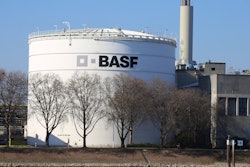A passive layer protects the surface of stainless steels against corrosion and ongoing dissolution of material. Corrosive damage on piping systems and tanks can occur when the passive layer on new pipes or tanks has not formed properly. TÜV SÜD Chemie Service participated in the assessment of KorroPad, a method for characterizing the passive layer on stainless steel, which was developed by Germany’s federal testing institute Bundesanstalt für Materialforschung und -prüfung.
Stainless steels used in installations for the chemical industry are exposed to extreme environmental conditions, including direct contact with acids, corrosive gases, or fluids with high chloride content. The condition of the protective passive layer on the stainless steel surface directly impacts on the safety and profitability of a plant.
Defects in the passive layer, caused by treatment of stainless steel while in new condition or by the effect of fluids, quickly lead to corrosion. However, breaks or faults in the passive layer are invisible to the naked eye. Traditional methods for verifying that the passive layer is intact (e.g., salt-spray test and electrochemical measurements) present major financial hurdles for small and medium-sized enterprises.
TÜV SÜD Chemie Service routinely applies electrochemical methods to select safe and reliable materials, such as determination of pitting potential by plotting current density potential—curves in a measurement cell in the lab or localized on the component itself.
The objective was to evaluate how KorroPads compared to traditional electrochemical measurements to give users a simple on-site method if it proved suitable.
Sensitive Passive Layer
Stainless austenitic chromium-nickel-molybdenum steel (steel grades 1.4404 / 1.4401 / 1.4571) is made of around 70 percent iron plus the addition of further alloying elements. The most important alloying element for corrosion resistance is chromium, which forms a dense layer of chromium oxide on the stainless steel surface in the presence of water and oxygen.
This passive layer is only a few atom layers thin; it is thus not visible, but sensitive. If the passive layer is not fully formed, there is a risk of corrosion. The same also applies if imperfections are present in the material surface and prevent the passive layer from forming. The protective chromium oxide layer can regenerate in the presence of oxygen and moisture.
However, it can only provide permanent protection in the presence of the physical and chemical factors that are necessary for this regeneration of the passive layer, a process also referred to as repassivation. Crucial factors for repassivation include sufficient concentrations of oxygen, humidity, low concentrations of chloride ions, and clean, metallically bright surfaces.
Practical and Fast Alternative
KorroPads offers a cost-effective, non-destructive and, above all, rapid alternative to traditional methods when it comes to the testing of material surfaces. Its function is fascinatingly simple: If the passive layer is locally damaged, ferrous ions are released at the local defects in the protective layer. The gel-like KorroPads are saturated with water that contains small amounts of sodium chloride and a ferrous-ion indicator.
If the protective chromium oxide layer on the steel surface is absent, the indicator potassium hexacyanoferrate (III), which is yellow to transparent in aqueous solution, instantly changes to Prussian blue upon contact with the released ferrous ions. Local defects in the protective layer are indicated by clearly visible blue spots in the light-yellow pads. At these locations, the protective passive layer on the stainless steel surface is either non-existent or not fully formed.
Reliable Results Within 15 Minutes
The KorroPad procedure is a non-destructive testing method. It can be used to test the corrosion risk in pipe components and tanks for quality assurance before they are installed in a chemical plant. As an additional advantage, the rapid test is easy to use and does not require any previous knowledge in the fields of corrosion or electrochemistry.
Testing requires three pads, which are placed on the stainless steel. They provide a "snapshot" of the passive layer condition at the time of testing. The pads are roughly the size of a five Euro-cent coin. Before the KorroPads are placed on the surface and pressed down, the surface to be tested needs to be cleaned with acetone or alcohol.
After 15 minutes, the pads are removed using a plastic spatula and placed on a plastic carrier film. To ensure systematic evaluation and documentation, the test result can be scanned or photographed. If the test identifies a corrosion risk, the material experts will consult with the plant managers and agree on the next steps.
The most important question to be clarified in this context is whether the corrosion risk involves a hazard for the safety of the plant, or even for employee health and safety.
Tests Carried Out on Various Material Surfaces
The KorroPad test primarily is a surface-specific test method and can be used on all types of stainless steels. This was verified in comprehensive practice tests at TÜV SÜD Chemie Service. Tests were carried out on austenitic chromium-nickel-molybdenum steels. The KorroPad showed indications in all tests carried out on temper colors after welding.
In addition, the testers noted that electrochemical cleaning/polishing using devices designed for the purpose or mechanical treatments (such as brushing the weld seams) also resulted in indications to some extent. The indications demonstrate that temper colors had not been sufficiently removed and/or that no adequate repassivation had taken place.
Parallel to KorroPad tests, TÜV SÜD Chemie Service carried out local electrochemical measurements for comparison. The measurements showed low levels of pitting potential at those locations where KorroPad tests had resulted in indications. In other words, these locations had a higher risk of corrosion.
Another advantage of the KorroPad method is its ability to verify a good passive layer condition after cleaning by grinding, etching, or other methods and that no problems have to be expected during operation. The KorroPad method also proved to be suitable for quality assurance. For example, the method reliably detected surface defects on the outside of longitudinally welded pipes.
Improved Safety
The use of the KorroPad method helps stakeholders to help themselves. After all, virtually all material surfaces look perfectly clean and shining in the beginning. However, do components actually hold the promises made by their appearance and the name of their material?
In the field, this question is decided by a lot of different factors: What surface treatments were applied? Which post-treatment was used on welding seams? Are alloying elements evenly distributed?
The results of the KorroPad test quickly deliver answers to these and other questions. TÜV SÜD Chemie Service confirmed the suitability and the results obtained with this method in many tests and applications in the field.
Another crucial advantage is that the KorroPad method can be used to test the surface of stainless steels, both in as-delivered condition and after processing. Using the method, industrial trade operations can defend themselves against costly warranty claims.
Corrosion is more than merely a visual issue: Stainless steels frequently are used in the production of anchors and dowels, storage tanks for hazardous materials, and complex production systems. In that case, use of the KorroPad rapid test also helps support plant safety.
About the Authors
Dr. Helga Leonhard is materials test engineer at TÜV SÜD Chemie Service GmbH in Frankfurt, Germany. Jens Lehmann is research associate at Bundesanstalt für Materialforschung und –prüfung (BAM) in Berlin.






















